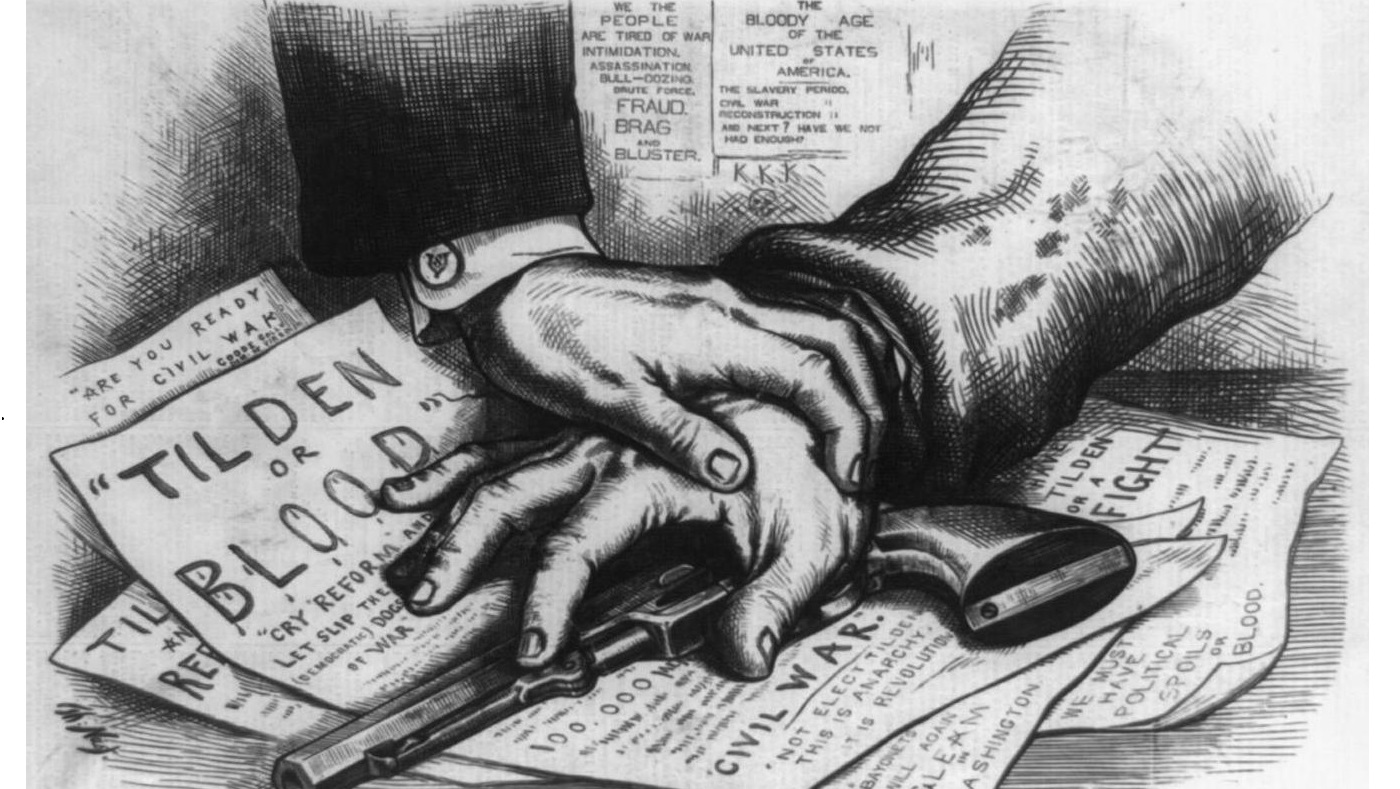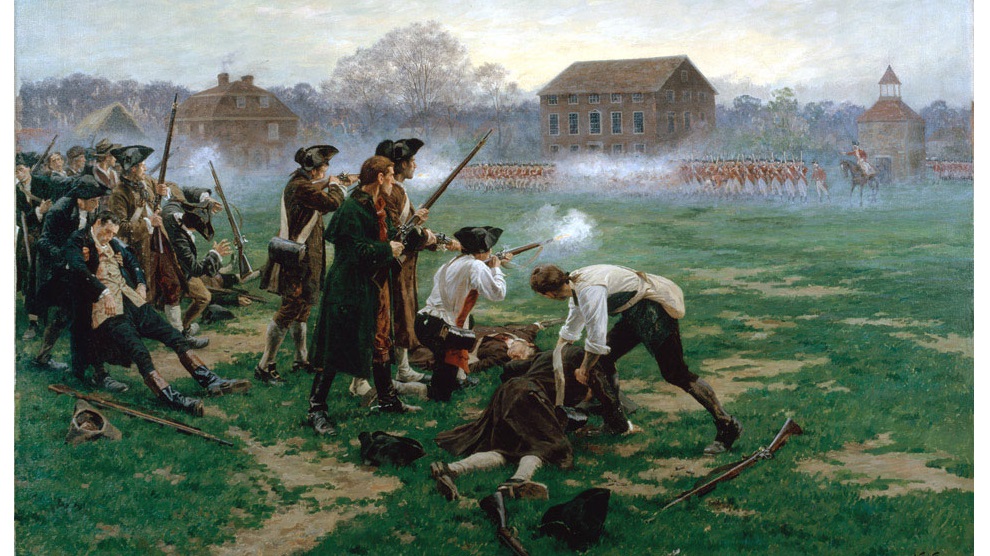The 60th quadrennial presidential election in the United States is in nine weeks, two months away. As the campaign season is heating up, let’s take a look at the very unusual election of 1876, which had to be decided by a special ‘Electoral Commission’ because of the rampant voter fraud, and which resulted in the end of the military occupation of the South by the North, an era known as Reconstruction.
President Lincoln promised Southern states not to outlaw slavery in the United States in order to prevent them from seceding—that promise, however, was not upheld. Two years into the Civil War, in January 1863, his Emancipation Proclamation came into effect, freeing all slaves in states in rebellion. That originally excluded the four so-called ‘border states’, states where slavery was legal but chose to stay with the Union: Delaware, Maryland, Missouri, and Kentucky.
After his reelection in 1864, and after General Lee of the Confederates surrendered to the Union’s General Grant at the Appomattox Court House in April 1865, President Lincoln did not stop his fight for the emancipation of enslaved people. While his original declaration was more of a practical war measure to dissuade the United Kingdom from joining the war on the side of the Confederacy (of which there was a real big chance prior), after the war, Lincoln did everything in his power to make African Americans full-right citizens in every state of the Union.
He managed to do so with the passing and ratification of the 13th, 14th, and 15th Amendments to the Constitution, which outlawed slavery, prescribed equal protection under the law for former slaves, and gave African Americans voting rights.
This completely changed the American political landscape.
Many believed that with black men voting in bloc in the Southern states, no Democrat would ever be elected President. However, that did not turn out to be the case.
First off, Democrat Andrew Johnson became President after the assassination of Abraham Lincoln on 15 April 1865, within a week of Lee’s surrender. Lincoln picked Johnson as his Vice President as part of a National Union ticket consisting of a Republican and a Democrat. Johnson was a Democrat Senator from Tennessee, who remained loyal to the Union despite his state’s secession.
President Lincoln made this move to bolster his reelection chances—at the time, no US President had been reelected for 32 years, since Andrew Jackson—but it ended up being a major mistake. Lincoln won reelection in a landslide, unsurprisingly, since 11 Southern, Democrat-stronghold states did not participate in the election due to the secession. Also, President Johnson was unable to work with a Republican cabinet in his almost full term in office. His lenient approach to letting Southern states reenter the Union and reconstruction also meant that the newly granted rights of African Americans were not enforced at all in the South. The Ku Klux Klan was founded and was allowed to run rampant in this period.
This changed with the—much closer than anticipated—election of General Ulysses S. Grant, the former Union major general, from the Republican Party in 1868. Grant cracked down on the Klan and was much more strict on reconstruction. He was reelected in 1872. However, corruption scandals in his administration and a financial crisis called the Panic of 1873 made him an unpopular President by the end of his second term.
This gave Democrats a real chance to win back the White House by the time the 1876 election came around, just 11 years after the Democrat-stronghold South lost a Civil War to the Republican-dominated North. The year also marked the centennial anniversary of the Declaration of Independence.
The Republican Party was embroiled in a fight within at the time. So-called ‘stalwarts’ faced off against the ‘half breeds’ for control of the party. The stalwarts were pushing to keep the old spoils system, in which the winning party awarded political positions to those who helped them get elected; while the half-breeds were advocating for merit-based appointments.
Ohio Governor Rutherford B. Hayes ended up being the Republican candidate. He was from the meritocratic, half breed section of the party. So much so that he vowed to serve just one term if elected, as opposed to the traditional two, given that he thought that a President’s reelection efforts could compromise his ability to do what was best for the country at times.
Meanwhile the Democrats, in order to garner voters from the North as well as the South, nominated a Northener, New York Governor Samuel Tilden for President. Tilden promised to end reconstruction if elected, so his base in the South was also solidified.
People in the United States were fired up to vote in this election. The 1876 presidential election holds the record for the highest turnout in American history, 82.5 per cent.
It seems that in some places, people were a little too fired up.
In South Carolina, state officials reported a 101 per cent voter turnout—this takes us to the biggest issue with the 1876 election, that is, rampant voter fraud.
Ballot stuffing, the discarding of valid ballots, and voter intimidation were so widespread that in three states—Florida, Louisiana, and South Carolina—no official result could be validated.
By the end of the election day, Samuel Tilden held a sizable lead in the popular vote and was just one electoral vote away from being elected President. Governor Hayes told reporters he was conceding the election when his party leaders told him to wait just a bit.
If all 19 electoral votes in dispute were to be given to Hayes, he would become the next President of the United States. Evidently, the country went into chaos, with many in the South calling for a second Civil War if Hayes was allowed to take office in such circumstances.
To resolve this thorny issue, a special Electoral Commission was established by Congress, consisting of 14 Senators and Congressmen, seven from the GOP and seven from the Democrats (with future President James Garfield in the line-up), as well as one independent Supreme Court Justice.
Voter fraud, suppression and partisanship: A look at the 1876 election
With nine days left until Election Day, many Americans hope the race finishes smoothly - unlike the disputed election of 1876. As the United States celebrated the centennial of the Declaration of Independence, a heated competition between Republican Rutherford B. Hayes and Democrat Samuel Tilden was rife with accusations of voter fraud and suppression.
Justice David Davis was originally intended to be the independent judge on the Commission. However, in a crucial mistake, the Democrat State Legislature of Illinois nominated him for Senate in order to sway his vote their way. This backfired, as Davis, generally viewed as more closely aligned with the Democrats, recused himself for losing his independent affiliation.
Justice Joseph P. Bradley, a Republican-friendly judge took his place instead, who voted in line with the Republicans, awarding all 19 electoral votes to Hayes.
Thus, Samuel Tilden, despite winning a clear majority of the popular vote (50.9 per cent), did not win the election. The electoral college broke to Hayes by the smallest margin in American history, just one vote, 185–184.
In order to avoid a second Civil War, President Hayes promised to fulfill his opponent’s agenda and end reconstruction. Federally appointed administrators and judges from the North would no longer be in charge of Southern states; and all federal troops from the North would leave as well.
In an ironic twist of events, Rutherford Hayes, who campaigned on an anti-corruption platform, became known as ‘Rutherfraud’
in his country after winning the dirtiest election in American history.
Governor Tilden, meanwhile, learnt to live with his unjust defeat. He later said of the election:
‘I can retire from public life with the consciousness that I shall receive from posterity the credit of having been elected to the highest position in the gift of the people, without any of the cares and responsibilities of the office.’
Related articles:








